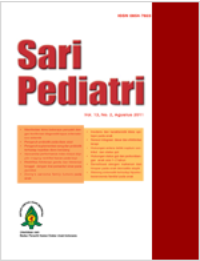Hubungan Kadar Serum Metabolit Nitrit Oksida dan Gangguan Fungsi Ginjal pada Sepsis
Sari
Latar belakang. Sepsis adalah respons sistemik terhadap infeksi dengan salah satu komplikasinya berupa gagal organ ginjal. Peran nitrit oksida (NO) sebagai mediator yang terlibat dalam mekanisme gagal organ ginjal kasus sepsis masih bersifat kontroversi.
Tujuan. Mengevaluasi hubungan antara kadar serum NO dan gangguan fungsi ginjal pada sepsis anak.
Metode. Desain penelitian potong lintang secara konsekutif dilaksanakan sejak bulan Juni sampai November 2012 dengan sampel anak usia satu bulan sampai lima tahun yang didiagnosis sepsis. Pemeriksaan kadar serum kreatinin mencerminkan fungsi ginjal dan kadar serum metabolit NO (nitrat dan nitrit) mencerminkan kadar NO endogen. Uji korelasi menggunakan uji korelasi Spearman, dinyatakan bermakna apabila p<0,05. Data diolah menggunakan piranti lunak SPSS 19.00
Hasil. Diperoleh 40 subjek dengan median usia 8,5 bulan (2 sampai 70 bulan) dan 22 di antaranya anak laki-laki. Kadar metabolit NO ditemukan berhubungan dengan kadar serum kreatinin (rs=0,33; p=0,041).
Kesimpulan. Terdapat hubungan antara peningkatan kadar serum NO dan terjadinya gangguan fungsi ginjal pada anak dengan sepsis.
Kata Kunci
Teks Lengkap:
PDFReferensi
Thomas NJ, Tamburro RF, Hall MW, Rajasekaran S,Venglarcik JS. Bacterial sepsis and mechanisms of microbial pathogenesis. Dalam: Nichols DG, penyunting. Rogers’ Textbook of Pediatric Intensive Care. Edisi 4. United State of America: Lippincott Williams & Wilkins; 2008.h.1300-27.
Weighardt H, Holzmann B. Role of Toll-like receptor responses for sepsis pathogenesis. Immunobiology 2007;212:715-22.
Goldstein B, Giroir B, Randolph A, members of International Consensus Conference on Pediatric Sepsis. International pediatrics sepsis consensus conference: Definitions for sepsis and organ dysfunction in pediatrics. Pediatr Crit Care Med 2005;6:2-8.
Wang Z, Holhoff JH, Seely KA, Pathak E, Spencer III HJ, Gokden N, dkk. Development of oxidative stress in the peritubular capillary microenvironment mediates sepsis-induced renal microcirculatory failure and acute kidney injury. Am J Pathol 2012;180:505-16.
Hung DT, Baden LR. A new era for sepsis treatment? Understanding sepsis as a consequence of host immune response. Expert Opin Ther Patents 2002;12:181-92.
Von-Dessauer B, Bongain J, Molina V, Quilodrán J, Castillo R, Rodrigo R. Oxidative stress as a novel target in pediatric sepsis management. J Crit Care 2011;26:103e1-7.
Hollenberg SM, Cinel I. Bench-to-bedside review: Nitric oxide in critical illness-update 2008. Crit Care 2009;13:218.
Mackenzie IM, Garrard CS, Young JD. Indices of nitric oxide synthesis and outcome in critically ill patients. Anaesthesia 2001;56:326-30.
Mitaka C, Hirata Y, Yokoyama K, Wakimoto H, Hirokawa M, Nosaka T, dkk. Relationships of circulating nitrite/nitrate levels to severity and multiple organ dysfunction syndrome in systemic inflammatory response syndrome. Shock 2003;19:305-9.
Yang F, Comtois AS, Fang L, Hartman NG, Blaise G. Nitric oxide derived nitrate anion contributes to endotoxic shock and multiple organ injury/ dysfunction. Crit Care Med 2002;30:650-7.
Doughty L, Carcillo JA, Sandra K, Janine J. Plasma nitrite and nitrate concentrations and multiple organ failure in pediatric sepsis. Crit Care Med 1998;26:157-62.
Baines PB, Stanford S, Bishop-Bailey D, Sills JA, Thomson APJ, Mitchell JA, Fear SC, Hart CA, Petros AJ. Nitrite oxide production in meningococcal disease is directly related to disease severity. Crit Care Med 1999;27:1187-90.
Taylor BS, Geller DA. Molecular regulation of the human inducible nitric oxide synthase (iNOS) gene. Shock 2000;13:413-24.
Knotek M, Rogachev B, Wang W, Ecder T, Melnikov V, Gengaro PE, dkk. Endotoxemia renal failure in mice: role of tumor necrosis factor independent of inducible nitric oxide synthase. Kidney International 2001;59:2243-9.
Dear JW, Yasuda H, Hu X, Hieny S, Yuen PST, Hewitt SM, dkk. Sepsis-induced organ failure is mediated by different pathways in the kidney and liver: acute renal failure is dependent on MyD88 but not renal cell apoptosis. Kidney International 2006;69:832-6.
Regueira T, Andresen M, Mercado M, Downey P. Physiophatology of acute renal failure during sepsis. Med Intensiva 2011;35:424-32.
Schrier RW, Wang W. Acute renal failure and sepsis. N Engl J Med 2004;351:159-69.
Yamaguchi N, Jesmin S, Zaedi S, Shimojo N, Maeda S, Gando S, dkk. Time-dependend expression of renal vaso-regulatory molecules in LPS-induced endotoxemia in rat. Peptides 2006;27:2258-70.
Yousefipour Z, Oyekan A, Newaz M. Interaction of oxidation stress, nitric oxide and perioxisome proliferator activated receptor γ in acute renal failure. Pharmacology & Therapeutics. 2010;125:436-45.
Escames G, Lopez LC, Ortiz F, Ros E, Acuna-Casroviejo D. Age dependent lipopolysaccharide-induced iNOS expression and multiorgan failure in rats: effects of melatonin treatment. Experimental Gerontology 2006;41:1165-73.
Ho JT, Chapman MJ, O’Connor S, Lam S, Edward J, Ludbrook G, dkk. Characteristics of plasma NOx levels in sev ere sepsis: high interindividual variability and correlation with illness severity, but lack of correlation with cortisol levels. Clin Endocrinol 2010;73:413-20.
Wu L, Gokden N, Mayeux PR. Evidence for the role of reactive nitrogen species in polymicrobial sepsis induced renal peritubular capillary dysfunction and tubular injury. J Am Soc Neprol 2007;18:1807-15.
DOI: http://dx.doi.org/10.14238/sp15.4.2013.259-63
Refbacks
- Saat ini tidak ada refbacks.
##submission.copyrightStatement##
##submission.license.cc.by-nc-sa4.footer##
Email: editorial [at] saripediatri.org


Sari Pediatri diterbitkan oleh Badan Penerbit Ikatan Dokter Anak Indonesia
Ciptaan disebarluaskan di bawah Lisensi Creative Commons Atribusi-NonKomersial-BerbagiSerupa 4.0 Internasional.




